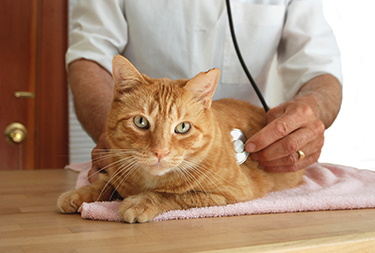Educating Clients: Cancer in Pets

Lumps, bumps, growths, and swellings are signs indicative of health issues that could be potentially life-threatening. As our pets continue to live longer lives, it is imperative that any symptom of a tumor be examined by a veterinarian.
Tumors: Two Basic Categories
Benign tumors:
- Not generally life-threatening
- Slow growing
- Do not spread to other parts of the body
- Do not invade neighboring tissue
- Cured by surgery if the entire tumor is able to be removed
Malignant tumors:
- Generally always considered life-threatening
- Damage healthy cells
- Grow in an unrestricted way
- Invade neighboring tissue
- Spread to other parts of the body and establish growth in other areas after entering the lymphatic or circulatory system
- Result of environmental factors or hereditary/genetic sources
- Appropriate treatment dependent on the health of the animal and the size, location, and stage of the tumor
Detection
Veterinarians are able to detect a large number of cancers through a physical examination of the animal. Detection can occur through:
- Visual identification:
- Cancers that appear as growths or sores on or beneath the skin
- Inspection and palpation:
- Cancers under the skin
- Example: Testicular or mammary gland cancers
- Hands-on examination:
- Swelling or lameness may indicate a cancer of the bone
Cancers that are found inside the body, such as in the spleen and liver, often show clinical signs before they are detected. Common symptoms include:
- Weight loss
- Vomiting
- Diarrhea
- Constipation
- Gastrointestinal bleeding
Physical Examination Recommendations
Companion animals are living longer today. Good food and living conditions plus increased and better opportunities for health care, are all indicative of our desire to have our pets live a good, long life. Since most cancers are discovered in middle-aged and senior dogs, clients need to remain vigilant with their veterinary visits if they want to detect a cancer in its earliest stage. One recommendation is that healthy animals seven years and older be given at least one yearly examination.
Clients need to know that the annual physical examinations provide baselines and screening information that could reveal the start of a change in the health of their pet. Early detection could improve the prognosis and prolong the animal’s life expectancy.
Yearly checkups may include:
- Physical examination
- Complete blood count
- Blood chemistries
- Urinalysis
- Parasite check
- Liver and kidney function tests
- Thyroid levels
- Chest x-ray
- Electrocardiogram
- Early renal disease health screen
Warning Signs
During the time between the yearly examinations, it is a good idea for clients to be aware of the warning signs of cancer. Any of the following symptoms indicate a need to schedule an appointment with the veterinarian.
- Lumps that do not go away, or ones that grow in size
- Abnormal odors
- Wounds that do not heal
- Abnormal discharges, such as blood, pus, diarrhea, vomiting
- Anemia
- Bloating
- Sudden weight loss
- Change in appetite
- Coughing
- Breathing difficulties
- Lethargy
- Depression
- Changes in urinary or bowel habits
- Pain
- Limping
- Swelling
The warning signs do not always mean to expect a diagnosis of cancer; but if they do, clients who know to be watchful, observant, and to contact their veterinarian right away, may help to save their pet’s life.
Want to hear more about ways to help clients with their pets? Contact your Covetrus North America representative at 855.724.3461
Careers
Are you looking for a place to let your talents shine? At Covetrus, we help our practitioner customers better serve their patients and take pride in providing the best customer experience possible. Search our open positions to see our available opportunities.
Newsletter
Stay current with what’s going on with Covetrus, subscribe to receive our newsletter and email communications. Subscribers will receive the latest information in practice management, sales and marketing, animal health, and more.


Leave a comment